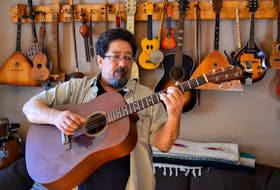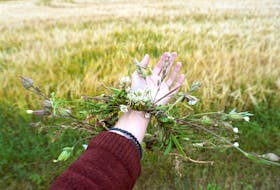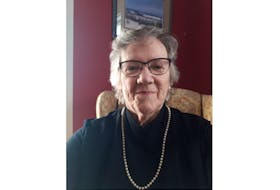They're the people you might pass by every day . You see them in the grocery store, at the coffee shop, in church and at local events. You may be able to call them by name, but you don't much about them. They all have a story. SaltWire reporters from across Atlantic Canada decided to seek out these ordinary people, have a conversation and tell their stories — in 300 words. Welcome to 2 Minutes With, stories of the extraordinary lives of ordinary people.

Willow van Lith
Finding her voice
The things that might scare most of us are subjects Willow van Lith finds ‘fascinating.’
Like the coyotes she can see from the kitchen window of her home. Or Delta, the family pit bull; looks a lot scarier than she really is.
Willow’s favorite book is “Tornado.” It’s about a rescue dog just like Delta. The dog in the book is called Tornado because of the way the family found him. He was dropped into their yard; dog house and all.
‘Twister’ is her favorite movie right now, along with ‘Black Hole Apocalypse’.
The first found object identified as a black hole is called Cygnus X-1. That’s also the name Willow gave her pet mouse. ‘Cyg’ for short.

KATHLEEN MELANSON PHOTO
Mars is a place the nine year old New Glasgow girl wants to go to someday; she wants to be the first woman to get there. Meanwhile her mind is on the ground where she likes learning about the way the world works.
• 3.8 billion years
• over 6 billion people
• The Akademik Ioffe (boat) functions as a research vessel. It has an international crew, representing Russia, Britain, New Zealand and Canada…
. . . just some of the things she has written while watching documentaries from the family’s video collection, kept in the tall cabinet her grandmother bought in a Montreal antique shop.
She likes people, but at some point began to feel scared that others would turn and stare if they heard her.
That was when she started school. Some days harder than others.
Diagnosis, selective mutism. She kept her distance from the things that made her anxious.
Hard to imagine now.
Willow likes to talk. She likes to be in the thick of it. Always has, her mother says.
It took some time, but she found her voice.

Donna Eldridge
Open doors and a warm welcome for all
Coffee drips into a pot. Space heaters purr. Outside air invades the warm space as people filter in. Some just need to use the bathroom. Others grab a cup of coffee or tea.
“Hey, that’s my mug!”
Donna Eldridge checks through her phone for messages. She’s trying get a return packaging order to print, but something’s screwy with the router, maybe.

Donna Eldridge and her husband Blaine Eldridge are the coordinators of Harvest House, a drop-in shelter and soup kitchen in Downtown Windsor. COLIN CHISHOLM PHOTO
For 17 years Donna and her husband Blaine have been holding things together at Harvest House, a walk-in homeless shelter and soup kitchen in downtown Windsor.
Some might think it’s an unlikely place for such a facility.
Windsor the door to the Annapolis Valley, with hills and fields and distant rivers, is miles away from a city — or from being a city – but there are still dozens, hundreds in need. It never stops.
Ding dong. The doorbell rings. The problems, the people, the needy, the food, the coffee, the tea. They keep coming.
Some just need a brief shelter from the outside, some a hot meal in their belly, some just acknowledgement that they exist, that they’re there.
Donna understands. She comes from a broken home. Her dad left and never came back. It was up to her mother to raise the four of them. Two bedrooms.

Donna Eldridge, coordinator of Harvest House in Windsor, said it’s always been in her heart to help others. COLIN CHISHOLM PHOTO
People helped them, and now she helps people – it’s a simple equation. Giving back, for 17 years now.
Her faith in Jesus in her rock and her strength. Her zen. She’s seen more people, more problems, more issues than most. But she feels she was put on this path by God and she’s going to stay on it.
Her grandmother was her inspiration, her joy. She opened her doors to all. She smiled. Food ready. She cared.
Donna applies those lessons to the hardship she sees.
Someone has to.
The coffee’s ready.

David Harvey
The constant man of Middleton
David Harvey heads up School Street, crosses Main in front of the post office.
Wheels his wagon up over the curb, down the alley behind Pizza Factory.
He used to head in the other direction to the bottle exchange at the old Hoyts building. Out to Hankinson’s before that. Now it’s a cube van in a parking lot Tuesdays.

David Harvey delivers another load of recyclables for the day; a routine that’s lasted 20 years. LAWRENCE POWELL PHOTO
Things change. David doesn’t.
He a constant in a small town. Never stays still. Icon for hard work. Wind, snow, rain – nothing stops him. Except Sundays. Sometimes he takes Sundays off.
He’s collected bottles since back in the ’90s. “When they started refunding them, anyway,” he says. “It’s a good job.”
A boy with a wagon is now a man with a wagon. The same quick grin though.
He’s 42.
He stops and talks. Reward not tied to money.
Friend Donny Biernell follows with a second wagon. Helps him out. These two big loads are a week’s work for David. Maybe 25 giant bags all told. Stuffed to bursting. They hang off the side racks like bumpers on a boat. A couple dozen bottles rolling around like loose change underneath.

David Harvey wheels his wagon through Middleton, Nova Scotia. LAWRENCE POWELL PHOTO
“I go ’round town, all the streets.”
Lots of walking, digging in bins, scouring ditches for those 10-cent pieces of gold. People are good to David. Businesses too.
Jim Shields counts David’s haul. Thousands of cans for a fistful of bills.
David has a free Roll Up The Rim coffee. He orders large, two cream. No sugar, since the diabetes. Walking helps keep sugars down.
It’s off to the Legion soup kitchen next – not for the free meal. He volunteers. Helps out. Cleans up.
Recently he donated $100. “For something to do,” he says. “Help keep them going.”
He’s a man about town. The heart of the Heart of the Valley.

George Wall
Walking against the wind
The wind is always most harsh near the beach, even in summer.
On a late winter morning, it carries a whiff of rain and a promise of Spring.
Crouched near a colourless, salt-stained railing, George Wall is bundled up in winter clothing. He huddles with Jesse, a brown and black mutt with a shy disposition.
Pets aren’t permitted where George lives; he borrows his son’s dog.
“I’ve been walking this beach three years now.”

ROSALYN ROY PHOTO
Man and dog walk this Port aux Basques beach every day, regardless of weather.
George watches Jesse run off ahead to play.
In one hand he carries a sturdy branch wrapped with white string; a make-shift walking stick.
“I take that with me in case I slip. I’ve got a bad back all the time, eh?”
Injured 15 years ago trying to lift a car that was stuck.
Then the time he swerved his car to avoid a head-on collision.
“I got my teeth all drove back.”
The worst was the motorcycle accident.
Sideswiped by another vehicle. Pitched in a tree-lined ditch filled with boulders. Broke his collarbone and ribs.
“I could see my boots come off.”
He chuckles about it now.
Wounds healed. He continued riding.
But the injuries added up.
The walking helps his back and his breathing, which he’s struggled with as a result of the accidents.
Then there’s Jesse. The dog loves the daily walks; doesn’t like going back home.
“He doesn’t want to get out of the car.”
The trail is hard in winter. Sea spray laces the gravel path with ice. But they don’t hesitate.
Jesse stops running long enough to look back and check for his friend.
George waves him on, hunching into the wind, following along in his own time, picking his way carefully with his trusty stick.

Dave Carey
It began with a grandmother’s gift
Tools line the walls in the small, downtown workshop.
Traditional tools, capable of intricate, precision work without the need of electricity.

Dave Carey with his ‘artistic director’ — six-month-old daughter Amelia in his downtown Sackville workshop. On the table is an intricately-crafted knife sheath he created during his his battle with cancer in 2008. SCOTT DOHERTY PHOTO
And power tools, modern day equipment that depends on the grid.
Dave Carey leans over the large worktable that dominates the small space, cutting and shaping animal hide into specific patterns.
The strong aroma of leather fills the air.
Dave’s journey of becoming a leather craftsman began several years ago, with a box of old books and tools handed down from his late grandmother.
Many items have taken shape under his hands since then.
He’s especially proud of an intricately-tooled knife sheath, painstakingly crafted, inspired partly from his love of Louis L’Amour western novels.
A reminder of his journey — as an artist and as a human being — where things didn’t always good smoothly.
Ten years ago, a particularly hard time.
It was 2008; diagnosis: Stage 4 Hodgkin’s lymphoma.
Gruelling eight months of treatments. The art of leather crafting enabled him to “keep some sanity.
“Just to keep doing something that wasn’t sitting there and being sick.”
The knife sheath was born.
Powerful build, large beard; Dave looks like he could have stepped straight out of the pages of the rough-and-tumble western novels he loves.

Dave Carey leafs through one of the books he received from his grandmother that sparked his interest in working with leather. SCOTT DOHERTY PHOTO
A soft-spoken voice and gentle demeanor quickly dispel first impressions.
And if tone of voice fails to convince, watching him cradle his “artistic director” – six-month-old daughter Amelia – in the crook of his tattooed arm seals the deal.
It’s his family that prompted him to channel his creativity into business.
Dave Carvey Leatherworks, Sackville, NB; brand new and full of optimism.
With a simple goal.
“I want to just be able to satisfy the needs of my little family. I want to be able to make enough that we can just live and enjoy our time together.”

Ernest Hingley
A lifetime of memories
The white-haired man sits in his wheelchair. On a table beside him a framed, sepia-toned picture of a five-year-old boy.
The picture bent and cracked, obviously damaged at some point. A little like the man himself. He bears his own scars from shrapnel blasted into his arm during the Second World War.

Ernie Hingley, veteran of the Second World War, with his wife Slyvia. HARRY SULLIVAN PHOTO
The mental scars aren’t as obvious but they’re there, too.
“Oh yes, it haunts me lots of times,” he told the journalist who interviewed him some years ago.
“I wake up at nights, you know, and the war’s going on right alongside of you.”
He sits in a wheelchair now.
Tacked to a bulletin board above his head is a poster of a young solider in a Canadian Army uniform bearing the name Cpl. Ernest William Hingley.

Ernie Hingley lied about his age to join the military. In 2016 he was awarded France’s Knight of the National Order of the Legion of Honour for his wartime service. HARRY SULLIVAN PHOTO
Ernie was 17 when he lied about his age to join the army. He was just 19 when he drove a truck off the landing craft at Normandy Beach during the Allied invasion to defeat Germany in 1944. The ugly scar on his arm a testament to the horrors he experienced.
So too, the memory of a shell exploding close enough to blow his boots off and kill his sergeant. And the time a bullet passed through his tunic, killing the soldier behind him.
The aged bedside picture in the nursing home where Ernie now lives is from a long-ago era when he ran about the fields and forests of his boyhood home in Kemptown.
He’s 94 now, doesn’t run anymore, doesn’t even walk.
As with many his age, a lot of memories are flashbacks to earlier times. More recent ones, sometimes harder to connect.
“Thanks for coming,” he says, smiling brightly and extending his hand.
His legs may be weak. But his mood and outlook are strong, his handshake firm.
Read Part 1: 2-minute reads - Part 1








